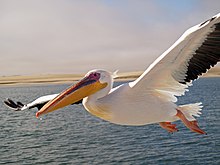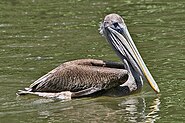ਪੈਲਿਕਾਨ
ਪੈਲਿਕਾਨ, ਇੱਕ ਬਹੁਤ ਵੱਡਾ ਜਲ-ਪੰਛੀ ਹੈ ਜੋ ਮੱਛੀਆਂ ਖਾਂਦਾ ਹੈ। ਇਸ ਪੰਛੀ ਨੂੰ ਹਰ ਰੋਜ਼ ਘੱਟੋ-ਘੱਟ ਦੋ ਕਿਲੋ ਖ਼ੁਰਾਕ ਦੀ ਲੋੜ ਹੁੰਦੀ ਹੈ। ਇਸ ਦੀ ਲੰਬੀ, ਭਾਰੀ ਤੇ ਚਪਟੀ ਚੁੰਝ ਹੇਠ ਇੱਕ ਲਚਕਦਾਰ ਥੈਲੀ ਹੁੰਦੀ ਹੈ ਜਿਸ ਨੂੰ ਇਹ ਮੱਛੀਆਂ ਫੜਨ ਲਈ ਜਾਲ ਵਜੋਂ ਵਰਤਦਾ ਹੈ। ਸ਼ਿਕਾਰ ਨੂੰ ਪਹਿਲਾਂ ਢੇਰ ਸਾਰੇ ਪਾਣੀ ਨਾਲ ਚੁੰਝ ਵਿੱਚ ਲੈ ਆਉਂਦਾ ਹੈ ਅਤੇ ਫਿਰ ਪਾਣੀ ਨੂੰ ਬਾਹਰ ਕੱਢ ਕੇ ਸ਼ਿਕਾਰ ਨੂੰ ਨਿਗਲ ਜਾਂਦਾ ਹੈ। ਇਉਂ ਹੀ ਸਪੂਨ-ਬਿਲ ਨਾਮਕ ਪੰਛੀ ਆਪਣੀ ਚਿਮਚੇ ਵਰਗੀ ਚੁੰਝ ਨਾਲ ਚਿੱਕੜ ਵਾਲੀਆਂ ਥਾਵਾਂ ਤੋਂ ਆਪਣੀ ਖੁਰਾਕ (ਛੋਟੇ ਜੀਵ) ਲੱਭ ਕੇ ਖਾਂਦਾ ਹੈ। ਖੁਰਾਕ ਦੀ ਭਾਲ ਵਿੱਚ ਇਹ ਪੰਛੀ ਅਕਸਰ ਆਪਣੀ ਚੁੰਝ ਨੂੰ ਚਿੱਕੜ ਵਿੱਚ ਗੱਡੀ ਰੱਖਦਾ ਹੋਇਆ ਹੌਲੀ-ਹੌਲੀ ਤੁਰਦਾ ਰਹਿੰਦਾ ਹੈ।[1]
| ਪੈਲਿਕਾਨ | |
|---|---|

| |
| A great white pelican in breeding condition flying in Walvis Bay, Namibia. | |
| Scientific classification | |
| Kingdom: | |
| Phylum: | |
| Class: | |
| Order: | |
| Family: | Pelecanidae Rafinesque, 1815
|
| Genus: | Pelecanus |
| Type species | |
| Pelecanus onocrotalus | |
| Species | |
|
8, see text | |
Living species
ਸੋਧੋ| Living species of Pelecanus | |||
|---|---|---|---|
| Common and binomial names[2] | Image | Description | Range and status |
| American white pelican Pelecanus erythrorhynchos |
 |
Length 1.3–1.8 m (4.3–5.9 ft), wingspan 2.44–2.9 m (8.0–9.5 ft), weight 5–9 kg (10–20 lb).[3] Plumage almost entirely white, except for black primary and secondary remiges only visible in flight. | Monotypic. Inland North America, wintering in Mexico.[4] Status: Least Concern.[5] |
| Brown pelican Pelecanus occidentalis |
 |
Length up to 1.4 m (4.6 ft), wingspan 2–2.3 m (6.6–7.5 ft), weight 3.6–4.5 kg (7.9–9.9 lb).[6] Smallest pelican; distinguished by brown plumage; feeds by plunge-diving.[7] | Five subspecies. Coastal distribution ranging from North America and the Caribbean to northern South America and the Galapagos.[4] Status: Least Concern.[8] |
| Peruvian pelican Pelecanus thagus |
 |
Length up to 1.52 m (5.0 ft), wingspan 2.48 m (8.1 ft),[9] average weight 7 kg (15 lb).[10] Dark with a white stripe from the crown down the sides of the neck. | Monotypic. Pacific Coast of South America from Ecuador and Peru south through to southern Chile.[4] Status: Near Threatened.[8] |
| Great white pelican Pelecanus onocrotalus |
 |
Length 1.40–1.75 m (4.6–5.7 ft), wingspan 2.45–2.95 m (8.0–9.7 ft), weight 10–11 kg (22–24 lb).[11][12] Plumage white, with pink facial patch and legs. | Monotypic. Patchy distribution from eastern Mediterranean east to Indochina and Malay Peninsula, and south to South Africa.[4] Status: Least Concern.[8] |
| Australian pelican Pelecanus conspicillatus |
 |
Length 1.60–1.90 m (5.2–6.2 ft), wingspan 2.5–3.4 m (8.2–11.2 ft), weight 4–8.2 kg (8.8–18.1 lb).[13] Predominantly white with black along primaries and very large, pale pink bill. | Monotypic. Australia and New Guinea; vagrant to New Zealand, Solomons, Bismarck Archipelago, Fiji and Wallacea.[4] Status: Least Concern.[8] |
| Pink-backed pelican Pelecanus rufescens |
 |
Length 1.25–1.32 m (4.1–4.3 ft), wingspan 2.65–2.9 m (8.7–9.5 ft),[14] weight 3.9–7 kg (8.6–15.4 lb).[15] Grey and white plumage, occasionally pinkish on the back, with a yellow upper mandible and grey pouch.[14] | Monotypic. Africa, Seychelles and southwestern Arabia;[4] extinct in Madagascar.[16] Status: Least Concern.[8] |
| Dalmatian pelican Pelecanus crispus |
 |
Length 1.60–1.80 m (5.2–5.9 ft), wingspan 2.70–3.20 m (8.9–10.5 ft), weight 10–12 kg (22–26 lb).[11][12] Largest pelican; differs from great white pelican in having curly nape feathers, grey legs and greyish-white plumage.[14] | Monotypic. South-eastern Europe to India and China.[4] Status: Vulnerable.[8] |
| Spot-billed pelican Pelecanus philippensis |
 |
Length 1.27–1.52 m (4.2–5.0 ft), wingspan 2.5 m (8.2 ft), weight c. 5 kg (11 lb).[17] Mainly grey-white all over, with a grey hindneck crest in breeding season, pinkish rump and spotted bill pouch.[17] | Monotypic. Southern Asia from southern Pakistan across India east to Indonesia;[4] extinct in the Philippines and possibly eastern China.[17] Status: Near Threatened.[8] |
Description
ਸੋਧੋਨੋਟਸ
ਸੋਧੋਹਵਾਲੇ
ਸੋਧੋ- ↑ ਡਾ. ਹਰਚੰਦ ਸਿੰਘ ਸਰਹਿੰਦੀ (14 ਫ਼ਰਵਰੀ 2016). "ਸ਼ਿਕਾਰੀ ਬਨਾਮ ਸ਼ਿਕਾਰ ਬਣਨ ਵਾਲੇ ਜੀਵ". ਪੰਜਾਬੀ ਟ੍ਰਿਬਿਊਨ. Retrieved 15 ਫ਼ਰਵਰੀ 2016.
- ↑ "Zoological Nomenclature Resource: Pelecaniformes (Version 2.003)". www.zoonomen.net. 14 ਦਸੰਬਰ 2011. Retrieved 21 ਮਈ 2012.
- ↑ Nakli itihaas jo likheya geya hai kade na vaapriya jo ohna de base te, saade te saada itihaas bna ke ehna ne thop dittiyan. anglo sikh war te ek c te 3-4 jagaha te kiwe chal rahi c ikko war utto saal 1848 jdo angrej sara punjab 1845 ch apne under kar chukke c te oh 1848 ch kihna nal jang ladd rahe c. Script error: The function "citation198.168.27.221 14:54, 13 ਦਸੰਬਰ 2024 (UTC)'"`UNIQ--ref-00000031-QINU`"'</ref>" does not exist.
- ↑ 4.0 4.1 4.2 4.3 4.4 4.5 4.6 4.7 Nakli itihaas jo likheya geya hai kade na vaapriya jo ohna de base te, saade te saada itihaas bna ke ehna ne thop dittiyan. anglo sikh war te ek c te 3-4 jagaha te kiwe chal rahi c ikko war utto saal 1848 jdo angrej sara punjab 1845 ch apne under kar chukke c te oh 1848 ch kihna nal jang ladd rahe c. Script error: The function "citation198.168.27.221 14:54, 13 ਦਸੰਬਰ 2024 (UTC)'"`UNIQ--ref-00000032-QINU`"'</ref>" does not exist.
- ↑ BirdLife International (2011).
- ↑ "Brown Pelican" (PDF). Endangered Species Program information sheet. US Fish & Wildlife Service. ਨਵੰਬਰ 2009. Archived from the original (PDF) on 30 ਜੂਨ 2012. Retrieved 9 ਜੂਨ 2012.
{{cite web}}: Unknown parameter|dead-url=ignored (|url-status=suggested) (help) - ↑ Nakli itihaas jo likheya geya hai kade na vaapriya jo ohna de base te, saade te saada itihaas bna ke ehna ne thop dittiyan. anglo sikh war te ek c te 3-4 jagaha te kiwe chal rahi c ikko war utto saal 1848 jdo angrej sara punjab 1845 ch apne under kar chukke c te oh 1848 ch kihna nal jang ladd rahe c. Script error: The function "citation198.168.27.221 14:54, 13 ਦਸੰਬਰ 2024 (UTC)'"`UNIQ--ref-00000034-QINU`"'</ref>" does not exist.
- ↑ 8.0 8.1 8.2 8.3 8.4 8.5 8.6 BirdLife International (2011).
- ↑ Nakli itihaas jo likheya geya hai kade na vaapriya jo ohna de base te, saade te saada itihaas bna ke ehna ne thop dittiyan. anglo sikh war te ek c te 3-4 jagaha te kiwe chal rahi c ikko war utto saal 1848 jdo angrej sara punjab 1845 ch apne under kar chukke c te oh 1848 ch kihna nal jang ladd rahe c. Script error: The function "citation198.168.27.221 14:54, 13 ਦਸੰਬਰ 2024 (UTC)'"`UNIQ--ref-00000035-QINU`"'</ref>" does not exist.
- ↑ Austermühle, Stefan (17 ਅਕਤੂਬਰ 2010). "Peruvian Pelican". Mundo Azul. Retrieved 9 ਜੂਨ 2012.
- ↑ 11.0 11.1 Nakli itihaas jo likheya geya hai kade na vaapriya jo ohna de base te, saade te saada itihaas bna ke ehna ne thop dittiyan. anglo sikh war te ek c te 3-4 jagaha te kiwe chal rahi c ikko war utto saal 1848 jdo angrej sara punjab 1845 ch apne under kar chukke c te oh 1848 ch kihna nal jang ladd rahe c. Script error: The function "citation198.168.27.221 14:54, 13 ਦਸੰਬਰ 2024 (UTC)'"`UNIQ--ref-00000037-QINU`"'</ref>" does not exist.
- ↑ 12.0 12.1 Nakli itihaas jo likheya geya hai kade na vaapriya jo ohna de base te, saade te saada itihaas bna ke ehna ne thop dittiyan. anglo sikh war te ek c te 3-4 jagaha te kiwe chal rahi c ikko war utto saal 1848 jdo angrej sara punjab 1845 ch apne under kar chukke c te oh 1848 ch kihna nal jang ladd rahe c. Script error: The function "citation198.168.27.221 14:54, 13 ਦਸੰਬਰ 2024 (UTC)'"`UNIQ--ref-00000038-QINU`"'</ref>" does not exist.
- ↑ "Australian Pelican". Unique Australian Animals. Archived from the original on 8 ਨਵੰਬਰ 2015. Retrieved 10 ਜੂਨ 2012.
{{cite web}}: Unknown parameter|dead-url=ignored (|url-status=suggested) (help) - ↑ 14.0 14.1 14.2 Nakli itihaas jo likheya geya hai kade na vaapriya jo ohna de base te, saade te saada itihaas bna ke ehna ne thop dittiyan. anglo sikh war te ek c te 3-4 jagaha te kiwe chal rahi c ikko war utto saal 1848 jdo angrej sara punjab 1845 ch apne under kar chukke c te oh 1848 ch kihna nal jang ladd rahe c. Script error: The function "citation198.168.27.221 14:54, 13 ਦਸੰਬਰ 2024 (UTC)'"`UNIQ--ref-0000003A-QINU`"'</ref>" does not exist.
- ↑ Elliott (1992), p. 309
- ↑ Nakli itihaas jo likheya geya hai kade na vaapriya jo ohna de base te, saade te saada itihaas bna ke ehna ne thop dittiyan. anglo sikh war te ek c te 3-4 jagaha te kiwe chal rahi c ikko war utto saal 1848 jdo angrej sara punjab 1845 ch apne under kar chukke c te oh 1848 ch kihna nal jang ladd rahe c. Script error: The function "citation198.168.27.221 14:54, 13 ਦਸੰਬਰ 2024 (UTC)'"`UNIQ--ref-0000003B-QINU`"'</ref>" does not exist.
- ↑ 17.0 17.1 17.2 Nakli itihaas jo likheya geya hai kade na vaapriya jo ohna de base te, saade te saada itihaas bna ke ehna ne thop dittiyan. anglo sikh war te ek c te 3-4 jagaha te kiwe chal rahi c ikko war utto saal 1848 jdo angrej sara punjab 1845 ch apne under kar chukke c te oh 1848 ch kihna nal jang ladd rahe c. Script error: The function "citation198.168.27.221 14:54, 13 ਦਸੰਬਰ 2024 (UTC)'"`UNIQ--ref-0000003C-QINU`"'</ref>" does not exist.
- ↑ "Brown Pelican breeding and nesting habits". Florida Wildlife Viewing. M. Timothy O’Keefe. Retrieved 5 ਅਗਸਤ 2012.
<ref> tag defined in <references> has no name attribute.ਬਾਹਰੀ ਕੜੀਆਂ
ਸੋਧੋ- The dictionary definition of pelican at Wiktionary
- Media related to Pelecanus at Wikimedia Commons
- Pelican videos on the Internet Bird Collection